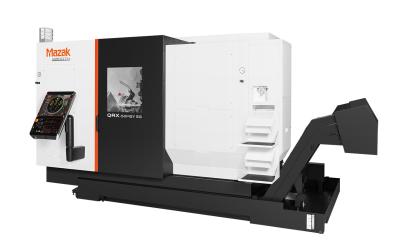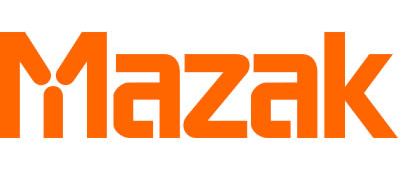
Mazak is unveiling its QRX-50MSY CNC turning center that provides manufacturers the speed and versatility for high-volume production of small, intricate parts in a compact, affordable machine.
Debuting at the company's Discover 2025 event at its Florence, Kentucky, facility, the QRX-50MSY’s combination of milling capability, second turning spindle and Y-axis functionality with advanced technology, productivity and value delivers exceptional performance for shops machining small parts such as EV input shafts, mid-shafts, valve fittings, and other components exceeding 2" in diameter.
The QRX-50MSY is the latest adaptation of Mazak’s versatile and efficient HQR Series 2-turret/2-spindle CNC turning center, which features similar milling and Y-axis functions. The QRX-50MSY boasts a 15% smaller footprint with floor dimensions of 119.3" (3,030 mm) by 86.6" (2,200 mm) while maintaining throughput and reduced cycle times.
Additionally, the QRX-50MSY’s modular design uses common machine components such as identical left and right spindles, upper and lower turrets and upper and lower carrier drives. The modular nature of the QRX-50MSY keeps machine cost down to maximize a manufacturer’s return on investment when producing small parts.
The QRX-50MSY sports a maximum bar diameter capacity of 2.0" (50 mm) with a 6" (152 mm) diameter chuck and features a slant bed design. The main and second spindles use 20 hp (15 kW) motors that provide maximum speeds of 6,000 rpm. The 12-station/24-tool position upper and lower turrets feature 7.0 hp (5.3 kW) rotary tool spindles that offer maximum speeds of 6,000 rpm.
The machine’s toolholding utilizes a BMT (Basic Metric Tooling) 45 interface for fast, precise tool changes and optimized performance. The interface uses static and driven tools and supports a wide range of tool holder types, including radial, axial and angular holders. The BMT 45 interface allows tools to be rotated 180 degrees for use on second operations, eliminating the need for tool changes between the operations.
The QRX-50MSY is equipped with a work unloader over the top of the second spindle that shops can equip with a gripper or parts bucket to remove parts from the machine. An auto parts catcher mounted on the lower turret catches parts at the second spindle head, or positioned beneath the main spindle, it can also accommodate end-of-bar remnants.
The machine comes standard with the Mazatrol SmoothG CNC that includes Mazatrol conversational programming as well as EIA-ISO G-code programming capabilities. The control provides unsurpassed ease of operation with its 19-inch touch screen and 3D model-based graphical user interface for intuitive operation like that of smartphones and tablets. The control also incorporates a wide variety of advanced programming functions for complete ease of use and high-speed, high-accuracy machining performance.
Every Mazak machine is backed by Mazak MPower Complete Customer Care, the industry’s most comprehensive machine support program. Plus, Mazak Capital Equipment Financing (MCEF) allows shops to easily move their manufacturing forward with one-stop, factory-direct financing on Mazak equipment.
Contact Details
Related Glossary Terms
- G-code programming
G-code programming
Programs written to operate NC machines with control systems that comply with the ANSI/EIA RS-274-D-1980 Standard. A program consists of a series of data blocks, each of which is treated as a unit by the controller and contains enough information for a complete command to be carried out by the machine.
- chuck
chuck
Workholding device that affixes to a mill, lathe or drill-press spindle. It holds a tool or workpiece by one end, allowing it to be rotated. May also be fitted to the machine table to hold a workpiece. Two or more adjustable jaws actually hold the tool or part. May be actuated manually, pneumatically, hydraulically or electrically. See collet.
- computer numerical control ( CNC)
computer numerical control ( CNC)
Microprocessor-based controller dedicated to a machine tool that permits the creation or modification of parts. Programmed numerical control activates the machine’s servos and spindle drives and controls the various machining operations. See DNC, direct numerical control; NC, numerical control.
- conversational programming
conversational programming
Method for using plain English to produce G-code file without knowing G-code in order to program CNC machines.
- gang cutting ( milling)
gang cutting ( milling)
Machining with several cutters mounted on a single arbor, generally for simultaneous cutting.
- milling
milling
Machining operation in which metal or other material is removed by applying power to a rotating cutter. In vertical milling, the cutting tool is mounted vertically on the spindle. In horizontal milling, the cutting tool is mounted horizontally, either directly on the spindle or on an arbor. Horizontal milling is further broken down into conventional milling, where the cutter rotates opposite the direction of feed, or “up” into the workpiece; and climb milling, where the cutter rotates in the direction of feed, or “down” into the workpiece. Milling operations include plane or surface milling, endmilling, facemilling, angle milling, form milling and profiling.
- modular design ( modular construction)
modular design ( modular construction)
Manufacturing of a product in subassemblies that permits fast and simple replacement of defective assemblies and tailoring of the product for different purposes. See interchangeable parts.
- turning
turning
Workpiece is held in a chuck, mounted on a face plate or secured between centers and rotated while a cutting tool, normally a single-point tool, is fed into it along its periphery or across its end or face. Takes the form of straight turning (cutting along the periphery of the workpiece); taper turning (creating a taper); step turning (turning different-size diameters on the same work); chamfering (beveling an edge or shoulder); facing (cutting on an end); turning threads (usually external but can be internal); roughing (high-volume metal removal); and finishing (final light cuts). Performed on lathes, turning centers, chucking machines, automatic screw machines and similar machines.

